معرفی

In the realm of construction and civil engineering, bulldozer machines have emerged as indispensable tools, reshaping how projects are planned and executed. Their robustness, versatility, and efficiency have revolutionized various aspects of construction, from earthmoving to site preparation and beyond. This blog delves deep into the profound impact bulldozer machines have had on the industry, tracing their evolution, detailing their operational components, exploring their applications across different sectors, and contemplating future advancements.
History of Bulldozer Machines
Early Developments
Bulldozer machines have a rich history dating back to the early 20th century when agricultural tractors were first adapted with steel blades for pushing soil and debris. This innovation marked the birth of the modern bulldozer concept, which quickly gained traction in both military and civilian applications during World War I and II. The transition from gasoline to diesel engines in the 1930s significantly boosted their power and reliability, setting the stage for widespread adoption in construction and infrastructure projects.
پیشرفت های تکنولوژیکی
Over the decades, bulldozer technology has undergone continuous advancements. Hydraulic systems replaced earlier cable-operated controls, offering greater precision and efficiency in blade and ripper operations. Modern bulldozers are equipped with sophisticated GPS and telematics systems, enabling precise grading and earthmoving tasks with minimal operator intervention. These technological leaps have not only enhanced productivity but also improved safety and environmental stewardship in construction practices.
Impact on Construction Practices
The introduction of bulldozer machines revolutionized construction practices by streamlining earthmoving tasks and significantly reducing labor requirements. Their ability to handle diverse terrains and conditions makes them indispensable in infrastructure development, road building, mining operations, and urban construction projects. Bulldozers enable faster project completion times, lower operational costs, and enhanced site safety, making them a cornerstone of modern construction methodologies worldwide.
Anatomy of a Bulldozer Machine
Components Overview
A typical bulldozer comprises several key components, including a robust chassis, a powerful diesel engine, and a hydraulic system that controls the movement of its blade and other attachments. The blade itself comes in various types—straight, U-shape, and combination blades—each tailored for specific tasks such as grading, leveling, and pushing materials. Modern bulldozers may also feature optional attachments like rippers for breaking up hard ground or winches for pulling heavy objects.
Engine and Power Systems
The heart of a bulldozer is its engine, typically a high-torque diesel engine designed to deliver ample power for heavy-duty operations. Advances in engine technology have led to greater fuel efficiency and reduced emissions, aligning with stringent environmental regulations. Hydraulic systems play a crucial role in bulldozer functionality, powering the movement of the blade and controlling auxiliary functions with precision. This integration of power and control systems ensures optimal performance and reliability in demanding construction environments.
Blade Types and Functions
The blade is arguably the most critical component of a bulldozer, dictating its capabilities and versatility. Straight blades excel in simple pushing and grading tasks, while U-shape blades are ideal for carrying and dumping materials. Combination blades offer a hybrid design, combining the functionalities of both straight and U-shape blades for enhanced versatility in various construction applications. Blade angle adjustment and tilt capabilities further enhance a bulldozer’s ability to perform precise earthmoving tasks across different terrains and project requirements.
Comparison of Bulldozer Types
| Feature | Crawler Bulldozers | Wheel Bulldozers |
|---|---|---|
| Mobility | Excellent traction on rough terrain | Better speed on flat surfaces |
| Typical Use Cases | Heavy-duty earthmoving | Lighter tasks, urban environments |
| قابلیت مانور | Slower maneuvering | More agile |
| Maintenance Needs | Higher maintenance due to tracks | Lower maintenance, simpler design |
Types of Bulldozer Machines
Crawler Bulldozers
Crawler bulldozers, also known as track-type tractors, are characterized by their continuous tracks, which provide superior traction and stability on uneven or soft terrain. These heavy-duty machines excel in large-scale earthmoving projects, such as mining operations and major infrastructure developments. Their low ground pressure minimizes soil compaction, making them suitable for environmentally sensitive areas where preserving natural landscapes is paramount.
Wheel Bulldozers
Wheel bulldozers feature tires instead of tracks, offering greater speed and maneuverability on flat or paved surfaces. These machines are commonly used in urban construction projects, where agility and mobility are essential for navigating tight spaces and congested areas. Wheel bulldozers are preferred for lighter earthmoving tasks and site preparation in urban environments, contributing to efficient project timelines and operational flexibility.
Specialized Variants
In addition to crawler and wheel bulldozers, there are specialized variants designed for specific applications. Swamp bulldozers are equipped with wider tracks or pontoons to traverse soft, marshy terrain without sinking. Waste handling bulldozers feature protective guards and enhanced cooling systems to operate in landfill environments safely. These specialized variants highlight the adaptability of bulldozer technology to meet diverse construction challenges and environmental conditions.
Applications in Construction
Earthmoving and Grading
Bulldozer machines are indispensable for earthmoving and grading tasks, including excavation, leveling, and shaping terrain to precise specifications. Their robust construction and powerful engines enable them to move large volumes of soil, gravel, and other materials efficiently. From foundation preparation to land reclamation projects, bulldozers play a pivotal role in ensuring the smooth execution of construction initiatives worldwide.
Clearing and Excavation
In land clearing operations, bulldozers excel in removing vegetation, debris, and obstacles to prepare sites for construction activities. Their ability to push and pile materials makes them essential for creating access roads, clearing rights-of-way for pipelines and power lines, and reclaiming land for agricultural or industrial purposes. Bulldozers equipped with rippers can break up compacted soil and rock, facilitating excavation and trenching operations with minimal effort.
Road Construction
Bulldozers are instrumental in road construction projects, where they assist in building and maintaining highways, streets, and rural roads. They play a critical role in establishing roadbeds, shaping slopes, and compacting materials to achieve the desired road profile and alignment. Bulldozers equipped with automated grade control systems ensure accurate grading and smooth pavement surfaces, enhancing road safety and durability. Their versatility in handling diverse soil types and gradients makes bulldozers indispensable for infrastructure development and transportation network expansion.
ملاحظات زیست محیطی
Efficiency and Fuel Consumption
Modern bulldozer designs prioritize fuel efficiency and reduced emissions to minimize their environmental footprint. Advances in engine technology, such as Tier 4 Final emission standards compliance, have significantly lowered pollutant emissions while improving fuel economy. Enhanced hydraulic systems and optimized powertrain configurations further contribute to overall operational efficiency, reducing both fuel consumption and carbon dioxide (CO2) emissions during construction operations.
Impact on Land and Ecosystems
Despite their efficiency, bulldozer machines can impact land and ecosystems, particularly in fragile environments. Soil compaction from heavy machinery can alter soil structure and reduce water infiltration, affecting plant growth and biodiversity. Proper environmental planning and mitigation strategies, such as using low ground pressure bulldozers or implementing erosion control measures, are essential to minimize ecological disturbances and preserve natural habitats during construction activities.
Technological Innovations for Sustainability
In response to environmental concerns, manufacturers are integrating sustainable practices and technologies into bulldozer designs. Electric and hybrid bulldozer prototypes are being developed to reduce reliance on fossil fuels and lower greenhouse gas emissions. Innovations in noise reduction and vibration damping technologies improve operator comfort and reduce environmental noise pollution. Additionally, real-time monitoring systems and telematics enable operators to optimize machine performance, minimize idle times, and reduce overall energy consumption during construction operations.
مزایای استفاده از Bulldozer Machines
Speed and Productivity
Bulldozer machines are prized for their speed and productivity in construction projects, enabling rapid completion of earthmoving, grading, and clearing tasks. Their high horsepower engines and efficient hydraulic systems allow them to handle large volumes of materials quickly, accelerating project timelines and reducing labor costs. From site preparation to final grading, bulldozers streamline construction workflows, ensuring timely project delivery and client satisfaction.
Cost Effectiveness
The cost effectiveness of bulldozer machines lies in their ability to perform diverse tasks with minimal downtime and operational expenses. Compared to manual labor or alternative equipment, bulldozers offer significant cost savings through increased efficiency, reduced labor requirements, and lower maintenance costs over their operational lifespan. Their versatility across different terrains and project scopes enhances project profitability by optimizing resource allocation and maximizing construction output.
Versatility in Terrain
Bulldozer machines exhibit unparalleled versatility in tackling various terrains and environmental conditions, from rocky landscapes to soft, marshy soils. Their robust undercarriage designs and traction systems enable them to navigate steep slopes, muddy terrain, and uneven ground with ease, ensuring stable operation and minimal terrain disturbance. This adaptability makes bulldozers suitable for a wide range of construction applications, including residential development, commercial building projects, and natural resource extraction operations.
Challenges and Limitations
Maintenance Requirements
Maintaining bulldozer machines involves regular inspections, servicing, and repairs to ensure optimal performance and longevity. Components such as tracks, hydraulic cylinders, and engine filters require routine maintenance to prevent breakdowns and minimize downtime during construction operations. Adequate training for maintenance personnel and access to genuine spare parts are crucial for maintaining bulldozer reliability and operational efficiency on site.
Operator Skills and Training
Operating bulldozer machines requires specialized skills and training to safely and effectively perform tasks in diverse construction environments. Operators must possess knowledge of machine controls, hydraulic systems, and safety protocols to prevent accidents and maximize productivity. Ongoing training programs and certifications ensure operators remain proficient in operating modern bulldozer technologies, including automated grade control systems and telematics for remote machine monitoring.
Environmental and Safety Regulations
Compliance with environmental and safety regulations is essential for bulldozer operators and construction companies to mitigate risks and minimize impacts on ecosystems and communities. Adhering to noise pollution limits, dust suppression measures, and waste management practices reduces environmental disturbances during construction activities. Implementing safety protocols, such as wearing personal protective equipment (PPE) and conducting pre-operation equipment checks, enhances workplace safety and reduces the likelihood of accidents or injuries on site.
Case Studies: Bulldozer Machine Projects
Urban Development Projects
In urban development, bulldozer machines are instrumental in transforming vacant lots and brownfield sites into thriving residential and commercial communities. They play a key role in land clearing, foundation excavation, and infrastructure installation, ensuring efficient land use and optimal site utilization. Bulldozers equipped with GPS and automated grade control systems enhance precision and accuracy in urban construction projects, minimizing disruptions to surrounding neighborhoods and enhancing project timelines.
Large-Scale Infrastructure
Bulldozer machines are essential for constructing large-scale infrastructure projects, such as highways, bridges, and dams, which require extensive earthmoving and grading operations. Their ability to handle heavy materials and navigate challenging terrains facilitates the creation of stable roadbeds, embankments, and structural foundations. Advanced bulldozer technologies, including remote monitoring and autonomous operation capabilities, improve project efficiency and safety on complex infrastructure sites, enhancing overall project delivery and stakeholder satisfaction.
Mining and Quarry Operations
In the mining and quarrying industry, bulldozer machines are utilized for extracting minerals, clearing overburden, and creating access roads to mining sites. Their rugged construction and powerful engines enable them to handle large volumes of materials, including ore, coal, and aggregates, efficiently. Bulldozers equipped with ripper attachments break up hard rock and compacted soils, facilitating excavation and trenching operations in challenging geological conditions. Their role in mining operations ensures the efficient extraction and processing of natural resources while maintaining site safety and environmental compliance.
Future Trends in Bulldozer Technology
اتوماسیون و رباتیک
The future of bulldozer technology lies in automation and robotics, with manufacturers developing autonomous bulldozer prototypes capable of performing repetitive tasks with minimal human intervention. Automated grade control systems and machine learning algorithms enable bulldozers to operate autonomously, adjusting blade angles and navigation paths in real time to optimize productivity and accuracy on construction sites. These advancements enhance operational efficiency, reduce labor costs, and improve overall project timelines in the construction industry.
Integration with IoT
Bulldozer machines are increasingly integrated with Internet of Things (IoT) technologies, enabling real-time monitoring of machine performance, fuel consumption, and operational metrics. IoT sensors and telematics systems transmit data to centralized platforms, allowing fleet managers and operators to remotely monitor and manage bulldozer fleets from anywhere in the world. Predictive maintenance algorithms analyze machine diagnostics and performance trends, preemptively identifying potential issues and scheduling maintenance to minimize downtime and maximize equipment uptime.
Advances in Materials and Design

Advances in materials science and engineering are driving innovations in bulldozer design, focusing on lightweight materials, advanced composites, and alternative power sources. Electric and hybrid bulldozer prototypes are being developed to reduce reliance on fossil fuels, lower emissions, and enhance energy efficiency during construction operations. Lightweight materials and improved aerodynamics improve bulldozer performance, agility, and fuel economy, contributing to sustainable construction practices and environmental stewardship.
نتیجه
Bulldozer machines have undeniably transformed the construction industry, offering unmatched capabilities in earthmoving, land clearing, and infrastructure development. As technology continues to evolve, these machines are poised to become even more efficient, environmentally friendly, and integral to modern construction practices. Understanding their history, applications, and future trends is crucial for anyone involved in or interested in the field of civil engineering and construction.
سوالات متداول
Q:What are the key features of a bulldozer machine?
A:Bulldozer machines typically feature a powerful diesel engine, a robust chassis with tracks or tires, and a hydraulically operated blade for pushing, leveling, and grading materials.
Q:How do bulldozer machines contribute to construction safety?
A:Bulldozer machines enhance construction safety by minimizing manual labor, reducing physical strain on workers, and incorporating safety features such as rollover protection structures (ROPS) and operator visibility enhancements.
Q:What advancements are expected in بولدوزر technology?
A:Future advancements in bulldozer technology include increased automation, integration with IoT for real-time monitoring, development of electric and hybrid models, and improvements in material design for enhanced performance and sustainability.


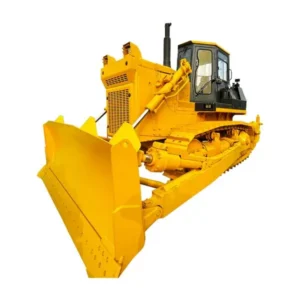
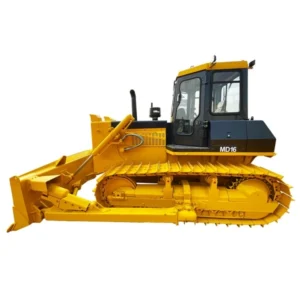
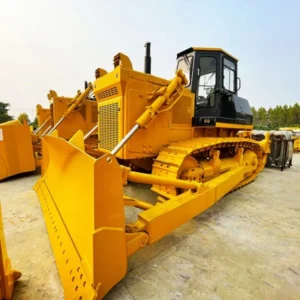
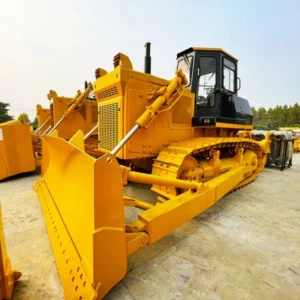
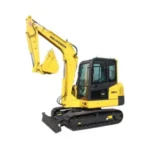

-150x150.webp)
